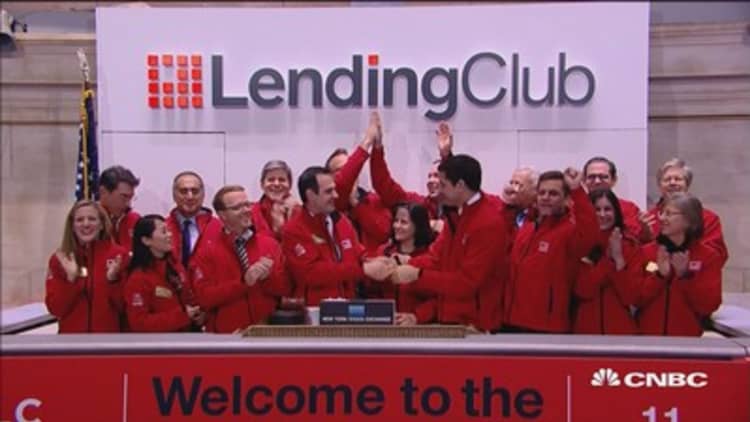
The most disruptive companies are continuing to grab the attention of the industry giants they're threatening—as well as investors looking for the next big thing. Five of the 50 companies on last year's second annual CNBC Disruptor 50 list "graduated," meaning they have gone public or been acquired. That's half the number that graduated last year from our 2013 list, and only two successfully pulled off an initial public offering.
So why the decline in exits among the CNBC Disruptor 50, especially after a torrid IPO market pace set in 2014?
Private companies are staying private longer or opting to be taken out by larger rivals. This is according to a recent financing trend reflected in the paths taken by companies on the annual CNBC Disruptor List of closely watched start-ups.
According to Renaissance Capital, an institutional market research firm that tracks the IPO market and offers an IPO ETF, last year marked the most active U.S. IPO market since 2000, with 275 companies going public and raising a stunning $85 billion. But so far this year, the IPO market has slowed dramatically.
The 34 IPOs in the first quarter raised $5.4 billion, making it the least-active quarter by IPO count since the the first quarter of 2013 and the smallest amount of IPO proceeds raised since the the third quarter of 2011. The proportion of IPOs with negative first-day returns remained above 30 percent for the second quarter in a row, according to Renaissance.
Market volatility, as well as widespread availability of private funding at very high valuations, dampened enthusiasm to seek IPO capital.
Read MoreEtsy IPO aims to prove its model
Another important factor in the lower deal proceeds overall was a lot less private equity-backed leveraged buyouts coming back into the public market, which tend to be bigger. Nevertheless, the shift in IPO investor sentiment can be seen in secondary equity deals for existing public companies, which have been faring better on a relative basis than IPOs.
First-quarter 2015 IPO trends
Number of deals in Q1 2014: 64
Number of deals in Q1 2015: 34
Number of VC-backed deals in Q1 2014: 40
Number of VC-backed deals in Q1 2015: 17
VC-backed deal proceeds Q1 2014: $3.2 billion
VC-backed deal proceeds Q1 2015: $1.3 billion
(Source: Renaissance Capital)
There's a chasm between losing money and breaking even, and investors are not looking over that chasm.Francis Gaskinspresident of IPO Desktop Premium
Etsy—No. 3 on last year's CNBC Disruptor List—not only debuted at a valuation that was a discount to the valuation from its last round of private financing, according to Kathleen Smith, principal at Renaissance Capital, but has also traded down since its offering, down 23 percent since its April IPO. [It went up 86 percent on its first day of trading.]
Smith noted that Box—a 2013 CNBC Disruptor—also went public at a discount to its last round of private financing.
"Both Etsy and Box opened at a higher price than the IPO deal pricing and then went down," said Francis Gaskins, president of IPO market tracker IPO Desktop Premium. The same was true for GoDaddy. Box is down 27 percent since its offering; GoDaddy is down 5 percent since its IPO.
Read More
"What's common about those three is that they are all losing money," Gaskins said. "There's a chasm between losing money and breaking even, and investors are not looking over that chasm," Gaskins said.
First-quarter 2015 IPO trading performance
Average first-day return of Q1 2014 IPOs: 20.3%
Average first-day return of Q1 2015 IPOs: 10.6%
Q1 2014 IPOs above issue price at quarter-end: 71.4%
Q1 2015 IPOs above issue price at quarter-end: 60.6%
Q1 2014 IPOs from tech sector: 22%
Q1 2015 IPOs from tech sector: 12%
(Source: Renaissance Capital)
Investors are concerned that Etsy has not yet turned a profit. Plus, as it expands, it faces the challenge of competing with giants eBay and Amazon.
"I'm interested to see how Etsy performs over the next six months," said Michael Dempsey of the research and data analysis team at CB Insights. "These nonprofitable high-growth companies—they aren't all Amazon—and public markets don't have the patience, especially when there is not the same understanding of what they are building, while they are losing money."
On Monday morning, Etsy shares dropped by as much as 10 percent after three Wall Street firms published skeptical to outright bearish ratings on the company. Wedbush Securities alleges in its sell rating that as many as two million items on Etsy, or around 5 percent of all merchandise, may potentially be either counterfeit or infringe on existing copyrights and trademarks. Etsy stock hit a new post-IPO low on Monday morning.
Lending Club, the world's largest martketplace for consumer loans, went public in December, raising nearly $870 million. The first-ever IPO of an online lending platform, Lending Club's IPO soared out of the gate, giving the company a valuation of some $9 billion, more than a number of banks, including Comerica, City National and CIT Group. But shares have been struggling—down 30 percent since its deal—on disappointing fourth-quarter results and lower than expected forecasts for the year.
Read More Why Uber is making America better
Lending Club—which was a CNBC Disruptor two years running and No. 33 last year—announced a number of big-name deals, strategic partnerships with Google and Alibaba, as well as a lending partnership with Citigroup, as it aims to show Wall Street some stability. The company's also looking for ways to expand and has recently announced it's developing a payment device.
Dempsey said IPO activity could pick up in the second half of the year but will partially depend on the performance of recent IPOs that are now "getting killed" as public companies recover in the second quarter.
The acquisition route
Private investors may be hesitant to face a valuation markdown triggered by an IPO as a reason they are keeping their start-up darlings funded for longer, according to Smith.
"Public markets are not buying into private market valuation inflation," Dempsey said. But, he added, "they're staying private for longer because they can."
"If you can take a company public at a $2 billion valuation or keep it private and have Fidelity Investments come in and give it a $4 billion valuation, that's more attractive," Dempsey said. He gave Twitter as an example of a company that went public before it had its business model figured out—in its case, advertising—and Twitter has paid the price in the public markets as a result, down 10 percent all-time since its IPO.
Other start-ups are opting to take the money from large corporations rather than test the public market appetite, particularly in the online advertising and media space.
There are the three Disruptor 50 companies that were acquired in the past year for a total of $1.44 billion: Fullscreen, Brightroll and, just as last year's list was published, Skybox Imaging.
Anything can happen along the way, because we're in an environment with lots of capital sloshing around on the private side, and when a model assumes a start-up will be a dominant player but others are being funded, the onus is on the tech companies.Kathleen Smithprincipal at Renaissance Capital
Brightroll, a digital video ad network that was No. 27 on last year's list, sold to Yahoo in November for $640 million. CEO Marissa Mayer snatched up the company as part of an acquisition spree to make Yahoo's video ad platform the largest in the U.S. The Internet giant said Brightroll was profitable, with net revenues of more than $100 million last year. The plan was to combine Yahoo's desktop and mobile ad inventory with Brightroll's platform to boost the bottom line.
Cashing in on the explosion of YouTube celebrities and the more than 55,000 online video creators in its network, Fullscreen—No. 21 on last year's CNBC Disruptor List—sold a majority stake to Otter Media, a joint venture between AT&T and the Chernin Group, Hollywood veteran Peter Chernin's media company. The September deal reportedly valued Fullscreen between $200 million and $300 million, though terms weren't disclosed. Fullscreen's acquisition follows Walt Disney's nearly $1 billion purchase of Maker Studios in April 2014.
SkyBox Imaging was snapped up by Google last June for half a billion dollars, ranking it at No. 14. The satellite imaging and analysis company built and launched the world's smallest high-resolution imaging satellite to further its mission of revolutionizing access to information about changes happening across the Earth. While Google said Skybox's up-to-date imagery will help to improve Google Maps, the company also said that over time they hope Skybox's team and technology will "help improve Internet access."
Still a lot left to prove
Last year was a banner year for IPOs because the equity indices' run of 2013 carried over into the next year's investor sentiment, but with the flattening in stocks this year—the is up 3 percent—the opportunity has narrowed.
Even the best bets in the IPO market are beginning to cool down. Led by biotechs, the health-care sector stayed active, accounting for half of all IPOs in the first quarter, but that action is slowing. "The wind is out of the biotech sails right now," Gaskins said.
Several biotech IPOs scheduled to price last week haven't yet made it to market, and even those that did have disappointed in pricing and early trading. "I might have said that you could go to market anytime with biotech, until about a week ago," Renaissance Capital's Smith said.
A U.S. and world economy that are not growing significantly, along with lots of market uncertainty, shortens the time horizon investors afford to start-ups to break even.
Read MoreWhy Warby Parker is turning heads
"The IPO market is healthy for profitable companies that have growth prospects," Gaskins said.
"There's a risk in companies that are very fast growing and don't have earnings and are spending a lot of marketing dollars," Smith said. "Anything can happen along the way, because we're in an environment with lots of capital sloshing around on the private side, and when a model assumes a start-up will be a dominant player but others are being funded, the onus is on the tech companies."
Or, in other words, many start-ups with good stories and the backing of Silicon Valley still have a lot to prove.
The 2015 CNBC Disruptor List will be unveiled on Tuesday. Follow coverage of the companies that made this year's list on CNBC and CNBC.com.






